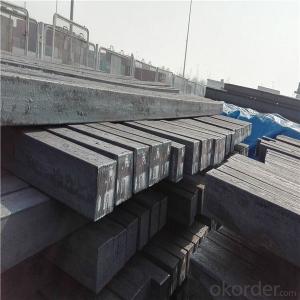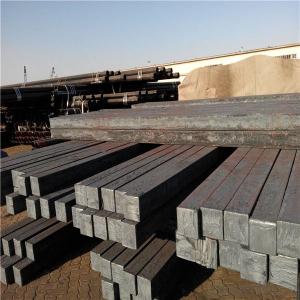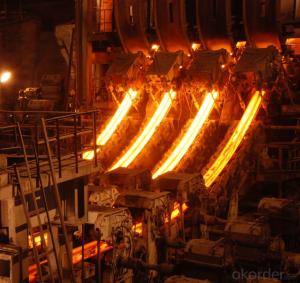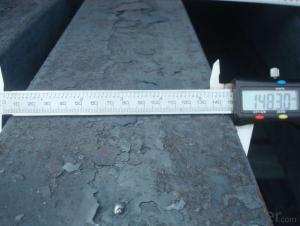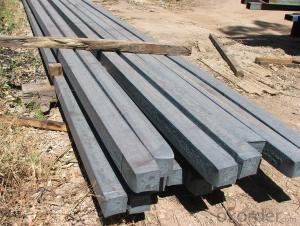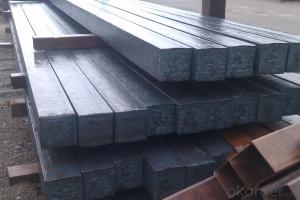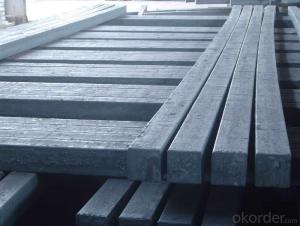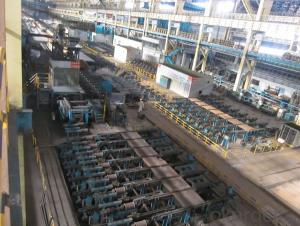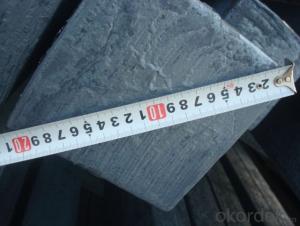Q275 Prime Steel Billet for hot roll steel prosucts
- Loading Port:
- Guangzhou
- Payment Terms:
- TT OR LC
- Min Order Qty:
- 1000 m.t.
- Supply Capability:
- 19983 m.t./month
OKorder Service Pledge
OKorder Financial Service
You Might Also Like
Specification
Billets, or ingots (as they sometimes referred to), are not of practical use until they have been formed into
more functional shapes and sizes. While they have already been put in the furnace, they still require a series
of shaping and molding procedures such as hot and cold working, milling and cutting before they are sold in
hardware stores, or used for different applications. The unformed billets, however, can be used in striking
currency such as coins and as reserves, similar to gold bars.
Qaulity:own factory, stable quality
Tolerance: Strictly according to the G/B and JIS standard
Delivery time: within 45 days after receiving the L/C or advanced T/T payment.
Price term: FOB/CIF/ CFR according to clients requirements
.
Gade:
Standard | C(%) | Mn(%) | S(%) | P(%) | Si(%) |
Q195 | ≤0.12 | ≤0.50 | ≤0.040 | ≤0.035 | ≤0.30 |
Q235 | ≤0.20 | ≤1.40 | ≤0.045 | ≤0.045 | ≤0.35 |
Q275 | ≤0.22 | ≤1.50 | ≤0.045 | ≤0.045 | ≤0.35 |
20MnSi | 0.17-0.25 | 1.2-1.6 | ≤ 0.050 | ≤ 0.050 | 0.40-0.80 |
3SP | 0.14-0.22 | 0.40-0.85 | ≤ 0.050 | ≤ 0.040 | 0.05-0.15 |
5SP | 0.28-0.37 | 0.50-1.00 | ≤ 0.050 | ≤ 0.040 | 0.15-0.30 |
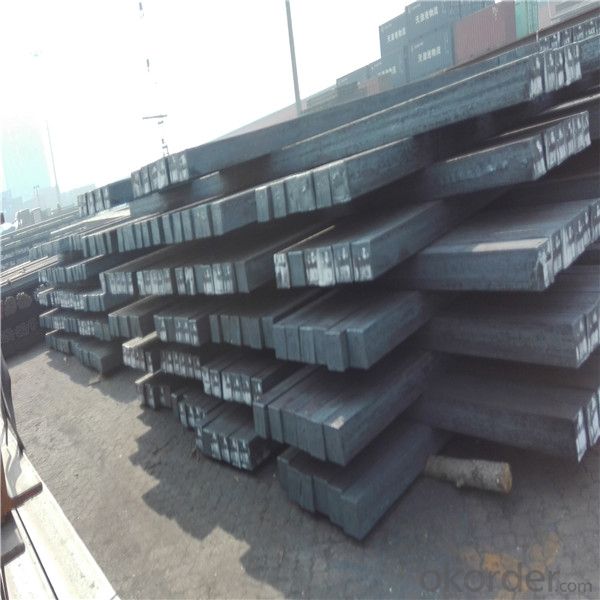
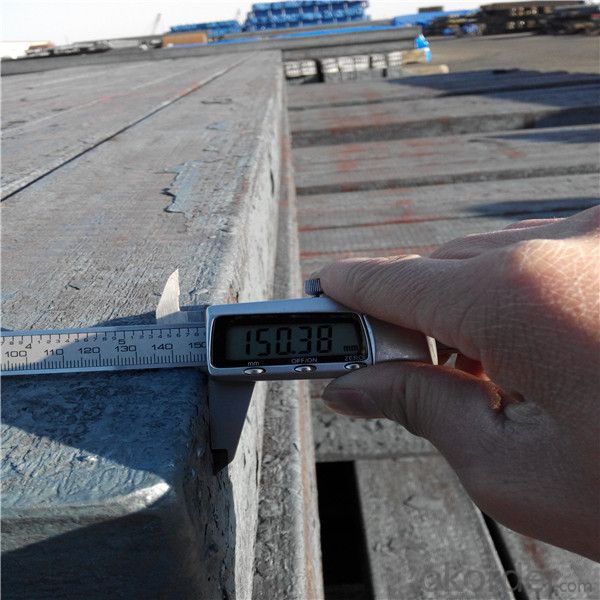
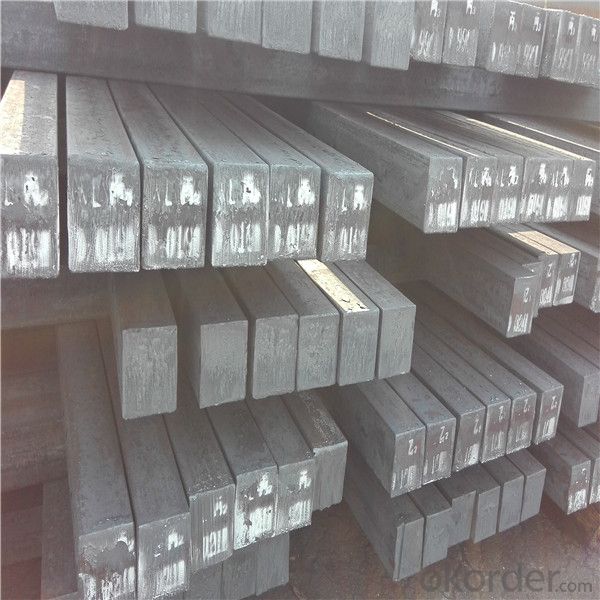
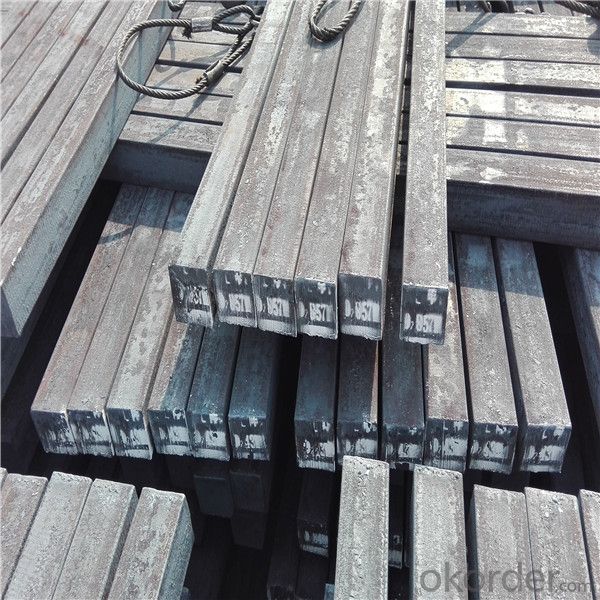
Our service :
We have a plant and professional team to provide our best service, from the start of production until the
loading into the vessel, we have a complete quality follow up procedure, to assure our products arrives to the customer with satisfaction. Welcome new and old customers
to contact us for future business relationships! We will give you a surpise price.
Packing :
Within 30 days
1.Standard export package
2.In bundles with steel strips
3.As the requirements of the customers
FAQ:
Q: What is payment terms?
A: FOB 30% T/T IN ADVANCE AS DEPOSIT AND 70% T/T BEFORE SHIPMENT
CIF and CFR 30% T/T IN ADVANCE AS DEPOSIT AND 70% T/T AS THE COPY OF B/L OR L/C AT SIGHT
Q:How to guarantee the quality of the products?
A:We have established the international advanced quality management system,every link from raw material
to final product we have strict quality test;We resolutely put an end to unqualified products flowing into the market.
At the same time, we will provide necessary follow-up service assurance.
Q:How long can we receive the product after purchase?
A :In the purchase of product within three working days, We will arrange the factory delivery as soon as possible.
The pecific time of receiving is related to the state and position of customers.
- Q: How are steel billets used in the manufacturing of automotive engine components?
- Steel billets are an essential raw material used in the manufacturing of automotive engine components. These billets are semi-finished steel products that are cast into specific shapes and sizes. They serve as the building blocks for various engine parts, such as crankshafts, connecting rods, camshafts, and cylinder blocks. Steel billets undergo a series of processes to transform them into engine components. The first step involves heating the billets to a high temperature, making them malleable and ready for forging or machining. Forging is a common method used to shape the billets into desired forms. It involves applying pressure and force to the heated billet to mold it into the required shape, such as the curved shape of a crankshaft. Once the billets have been forged into the desired shape, they undergo further machining processes to refine their dimensions and achieve the desired level of accuracy. This includes drilling, milling, turning, and grinding, which are performed using specialized machinery and tools. Machining ensures that the engine components meet the strict tolerances required for optimal performance and reliability. Steel billets are chosen for their exceptional strength, durability, and heat resistance properties. These characteristics are vital for engine components, as they are subjected to high pressures, temperatures, and loads during operation. Steel's high tensile strength and ability to withstand extreme conditions make it an ideal material for these critical parts. In summary, steel billets play a crucial role in the manufacturing of automotive engine components. Through forging and machining processes, they are transformed into highly precise and durable parts that contribute to the smooth and efficient operation of an engine. The use of steel billets ensures the overall quality and performance of automotive engines, making them an integral part of the manufacturing process.
- Q: How are steel billets used in the production of conveyor systems?
- Steel billets are an essential component in the production of conveyor systems as they are used to create the main structural framework. The billets are first heated and then passed through a series of rollers to shape them into the desired form of the conveyor system. This process, known as hot rolling, ensures that the steel billets are transformed into long, slender bars with a consistent cross-sectional shape. Once the steel billets have been shaped, they are further processed to create various components of the conveyor system. These components include conveyor frames, support beams, brackets, and other structural elements that provide stability and strength to the overall system. Steel billets are well-suited for this purpose due to their high tensile strength and durability. In addition to the structural components, steel billets are also used to produce conveyor rollers. These rollers are crucial for facilitating the movement of materials along the conveyor system. The steel billets are machined and formed into cylindrical shapes, which are then fitted with bearings to ensure smooth rotation. The rollers are then installed at regular intervals along the conveyor, allowing for efficient and continuous material handling. Moreover, steel billets are often used to manufacture conveyor belts. The billets are processed into thin sheets, which are then coated with various materials such as rubber or fabric to provide grip and durability. These belts are responsible for carrying the load of the materials being transported and are designed to withstand heavy usage and harsh environments. Overall, steel billets play a vital role in the production of conveyor systems by providing the necessary structural support, as well as components like rollers and belts. Their strength, durability, and versatility make them an ideal choice for constructing conveyor systems that can handle heavy loads and ensure efficient material handling in various industries.
- Q: How are steel billets used in the production of automotive exhaust systems?
- Steel billets are an essential component in the production of automotive exhaust systems. These billets, which are solid blocks of steel, serve as the raw material for various parts and components of the exhaust system. The first step in using steel billets is to heat them in a furnace to a specific temperature in order to soften the steel and make it malleable. Once heated, the billets are then shaped and formed into different parts of the exhaust system, such as pipes, mufflers, and catalytic converters. This shaping process can be done through hot rolling, cold rolling, or extrusion, depending on the desired shape and properties of the component. After shaping, the steel billets are further processed to enhance their strength and durability. This can involve heat treatment processes like quenching and tempering, which improve the steel's hardness, toughness, and resistance to corrosion. These treatments ensure that the exhaust system components can withstand the harsh conditions they will be exposed to, such as high temperatures and corrosive gases. Once the steel billets have been shaped and treated, they are then assembled and welded together to form the final exhaust system. This involves joining the various components, such as pipes and mufflers, through welding techniques like arc welding or laser welding. These welding processes ensure that the components are securely connected, preventing any leaks or failures in the exhaust system. Overall, steel billets play a crucial role in the production of automotive exhaust systems by providing the necessary raw material for shaping and forming the various components. Their strength, durability, and resistance to high temperatures and corrosion make them an ideal choice for manufacturing exhaust systems that can withstand the demanding conditions of automotive use.
- Q: What are the potential applications of steel billets in the packaging industry?
- Steel billets can be used in the packaging industry for various applications such as manufacturing metal cans, containers, and closures. They provide strength, durability, and resistance to external factors like pressure, impact, and corrosion. Additionally, steel billets can be molded into different shapes and sizes, making them suitable for diverse packaging requirements.
- Q: What are the different surface finishes available for stainless steel billets?
- Some of the different surface finishes available for stainless steel billets include mill finish, brushed finish, mirror finish, satin finish, and bead blasted finish.
- Q: What is the role of steel billets in the production of wire rods?
- Wire rods depend greatly on steel billets for their production. These long, cylindrical metal rods are widely utilized in construction, automotive, and manufacturing industries. To begin the production process of wire rods, steel is melted in either an electric arc furnace or a basic oxygen furnace. Once the desired temperature and composition are achieved, the molten steel is poured into molds, resulting in the formation of steel billets. Steel billets act as semi-finished products that serve as the initial stage in the wire rod manufacturing process. These solid bars of steel, which can be rectangular or round, undergo further processing to be transformed into wire rods. The conversion of steel billets into wire rods commences with a reheating process. The billets are subjected to high temperatures, making them more malleable and easier to manipulate. This reheating process is typically carried out in a reheat furnace. Following reheating, the billets are passed through a series of rolling mills. This reduces their size and shapes them into wire rods. These rolling mills apply a combination of pressure and heat to deform the steel billets, elongating them into long, thin rods. This rolling process also enhances the mechanical properties of the wire rods, such as their strength and flexibility. Once the wire rods are formed, they may undergo additional treatments, including cooling, surface treatments, and quality inspections. These treatments are necessary to meet the specific requirements of different applications. The wire rods can then be further processed into various products, such as wires, cables, reinforcement bars, or other specialized components. In conclusion, steel billets are a critical component in the production of wire rods. They serve as the starting material, undergoing various processing steps, such as reheating and rolling, to achieve the desired shape and properties of wire rods.
- Q: What are the different surface treatments applied to stainless steel billets?
- There are several different surface treatments that can be applied to stainless steel billets, depending on the desired outcome and application. Some common treatments include passivation, pickling, electropolishing, and blasting. Passivation helps to improve corrosion resistance by removing any free iron from the surface. Pickling involves the use of acids to remove impurities and oxide layers from the surface. Electropolishing is an electrochemical process that provides a smooth and shiny finish. Blasting, on the other hand, involves using abrasive particles to remove surface contaminants and create a textured finish. These treatments can enhance the appearance, cleanliness, and durability of stainless steel billets for various industrial applications.
- Q: What is the composition of steel billets?
- Steel billets are primarily composed of iron, with varying amounts of carbon and other alloying elements such as manganese, silicon, and chromium. The exact composition depends on the specific grade and intended use of the steel billet.
- Q: What are the different types of extrusion processes used for shaping steel billets?
- There are several different types of extrusion processes used for shaping steel billets. These processes are commonly employed in the manufacturing industry to produce a wide range of steel products with varying shapes and sizes. Some of the commonly used extrusion processes for shaping steel billets include: 1. Hot extrusion: This process involves heating the steel billet above its recrystallization temperature and then forcing it through a die to shape it into the desired form. The high temperature makes the steel more malleable, allowing for easier extrusion and shaping. 2. Cold extrusion: In contrast to hot extrusion, cold extrusion involves shaping the steel billet at room temperature or slightly above. This process is commonly used for producing smaller parts or components that require high precision and a smooth finish. 3. Direct extrusion: Direct extrusion involves placing the steel billet into a container or chamber with a die at one end. A ram or plunger is then used to apply force on the billet, pushing it through the die and shaping it into the desired form. This process is commonly used for producing long and continuous shapes, such as rods, tubes, and bars. 4. Indirect extrusion: In indirect extrusion, the steel billet is placed inside a chamber with a die at one end, similar to direct extrusion. However, in this process, the die is stationary, and the force is applied to the container or chamber, causing it to move and push the billet through the die. Indirect extrusion is often used for producing complex shapes that require more control over the extrusion process. 5. Impact extrusion: Impact extrusion is a specialized form of extrusion that involves shaping the steel billet using a high-velocity impact force. The billet is placed inside a die, and a punch or hammer strikes the billet, causing it to flow and shape into the desired form. This process is commonly used for producing hollow or tubular shapes, such as cans or containers. These are just a few of the different types of extrusion processes used for shaping steel billets. Each process has its own advantages and limitations, depending on the desired shape, size, and properties of the final product. Manufacturers choose the most appropriate extrusion process based on their specific requirements and considerations.
- Q: What are the different surface defects that can be found in steel billets?
- Some common surface defects that can be found in steel billets include cracks, scale, pits, inclusions, and surface roughness.
Send your message to us
Q275 Prime Steel Billet for hot roll steel prosucts
- Loading Port:
- Guangzhou
- Payment Terms:
- TT OR LC
- Min Order Qty:
- 1000 m.t.
- Supply Capability:
- 19983 m.t./month
OKorder Service Pledge
OKorder Financial Service
Similar products
Hot products
Hot Searches
Related keywords
